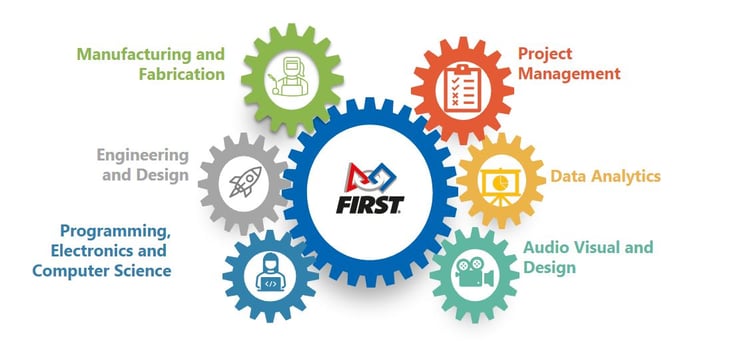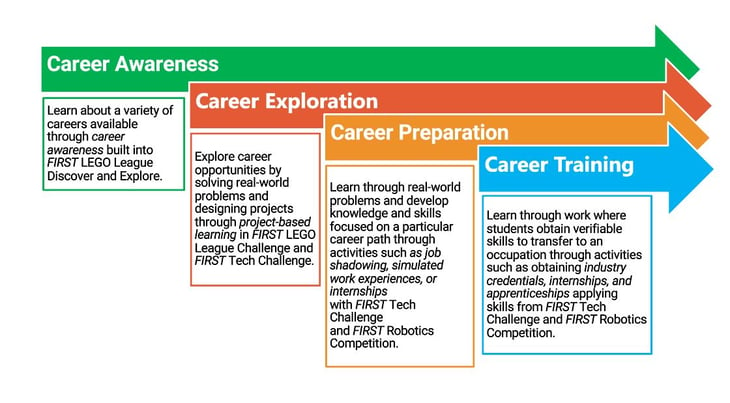By Lori Birch, Senior Specialist, Education Workforce Development, FIRST Education
Career and Technical Education (CTE) provides students and adults with the academic and technical skills, knowledge, and training necessary to succeed in future careers and develop skills they will use throughout their lives. FIRST® provides opportunities for schools to fulfill a workforce pipeline for high-skilled and high-demand jobs within CTE programs through work-based learning.
If you are an educator, FIRST mentor or coach, or FIRST team working to increase sustainability and support within your school or CTE program here are five strategies you can use to bolster your efforts:
1. Understand the History and Importance of CTEBefore we dive in: What is Career and Technical Education? Career and Technical Education (CTE) is the foundational infrastructure for secondary public schools in the United States for developing programs in their state related to career education. It originated with the Smith Hughes Act of 1917, which provided federal support for vocational (agriculture) education. According to the National Center for Education Statistics, 98 percent of public-school districts offer CTE programs.

This growth of CTE programs has expanded into STEM fields, with a focus on preparing students for rapidly growing STEM jobs through active, real-world, project-based learning. The U.S. Bureau of Labor Statistics projects STEM occupations to grow 11% from 2021 to 2031, twice as fast as non-STEM jobs.
That rapid growth leads to a need to grow young people’s awareness of those opportunities through work-based learning. According to this fact sheet produced by Association for Career and Technical Education (ACTE):
“Work-based learning (WBL) enables students to learn about careers, build connections with industry professionals, and develop and practice technical, academic and employability skills needed for career success. In fact, research finds that WBL helps students apply and extend classroom learning, gain motivation, and establish critical understanding of the work environment.”
FIRST aligns with these same work-based learning elements that school districts may be struggling to implement. FIRST® Tech Challenge and FIRST® Robotics Competition, and proven evidence to increase employability skills. See how FIRST helps prepare students for the New World of Work and why Educators Choose FIRST to promote and demonstrate these qualities in their learning environments.
2. Leverage FIRST participation to support career awareness and workforce developmentAll FIRST programs are designed using a project-based learning methodology that aligns to most state Career and Technical Education (CTE) frameworks for STEM, Engineering, and Manufacturing pathways.
FIRST Robotics Competition and FIRST Tech Challenge specifically provide opportunities for students to develop both technical and foundational/transferable skills, leadership opportunities, and direct tie-ins with career awareness.

Check out this blog on how students build a skill portfolio from their FIRST experience and how they build these skills and transfer that knowledge to future career.
3. Students can obtain industry certifications through FIRST, benefiting themselves and their schoolsOne way FIRST aligns with CTE programs is through connecting learning to industry certifications. Industry certifications are an indicator of school performance in many states. Students can gain industry certifications through their FIRST participation, which can help schools with their performance indicators and help key stakeholders see the value of FIRST program implementation (industry certifications can vary by state). Many industry certifications can be used as stackable credentials that can help students show their potential employers the skills they have, such as mastery of a particular software or hardware component (CAD, CNC Mill, CNC Lathe, or Final Cut). Other industry credentials provide a pathway directly into careers (e.g. Microsoft Office Specialist, CDL, CompTIA Security +, Autodesk Certified Professional). Specifically, there are several industry certifications included in the FIRST Robotics Competition Virtual Kit of Parts that students can utilize to add stackable credentials to their resume.
4. Leverage FIRST experience to create career opportunitiesFIRST Students can report to their school district the industry certifications they are pursuing and achieving. Many school districts are reimbursed for the industry certifications that their students achieve, and it also can help students achieve graduation requirements such as in Virginia. When school districts can see that program helps them achieve additional funding and performance measures they are more likely to keep supporting the program through space and funding.
5. Explore the Benefits of FIRST and School PartnershipsImplementing FIRST with alignment to Career and Technical Education programs help school districts tap into federal and state funding sources to fund expenses such as teacher stipends and supplies. We hear from schools that see the benefits of growing FIRST programs but struggle with challenges such as teacher involvement, workspace, and technical mentors. In our experience, we’ve found that schools that have Career and Technical Education pathways often have the physical space to allow teams to meet and equipment that can be used to build robots. Adding FIRST programs to the school experience can help increase performance indicators by providing work-based learning opportunities, serving underserved populations, and filling high-skilled and high-demand careers.
See how FIRST programs connect to Career and Technical Education and use Work-Based Learning to prepare students for the future. >Request More Information

